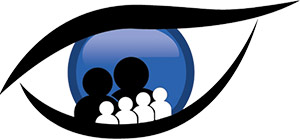Myopia control or myopia management is the area of children’s eye care dedicated to slowing down childhood myopia progression. Myopia in children may also be called being short-sighted or near-sighted. It involves your child’s eye care professional prescribing special types of spectacle lenses or glasses, contact lens or atropine eye drops to slow down worsening of their vision. Your eye care professional will also talk to you about your child’s visual environment – how much time they spend on screens and reading, and how much time they spend outdoors. You can click on the relevant words to learn more about each of these.
Myopia control and myopia management is important because it’s preferable to have lower numbers in a prescription, thinner glasses, and to avoid frequent changes in glasses prescriptions. Generally, once a child becomes myopic (or short-sighted, causing blurred distance vision) it tends to progress, or get worse, every few to several months. The younger a child becomes myopic, the faster they tend to progress, leading to higher levels of myopia. This means we should start a myopia management strategy as soon as possible. Click here to read more about when to start and when to stop myopia management.
But what’s the point of all of this fuss? Why do we want to slow down myopia progression? If they have to wear glasses anyway, does it matter if they’re stronger or weaker? Can’t they just get laser surgery as an adult to fix it?
Myopia control is about protecting eye health
Myopia in children may just seem like a pair of glasses. However, as childhood myopia worsens, the eye is growing at an accelerated rate. The eyes are meant to grow in childhood, at a regular rate up until age 10-12. However if they grow too quickly or don’t stop at age 10-12, then a child becomes myopic. This excessive growth of the eye stretches the retina – the light sensitive layer lining the back of the eye – and the stretching increases risk of eye diseases and vision impairment occurring across your child’s lifetime.
A normal eye length is 22 to 24mm. When the eye grows to longer than 26mm, the risk of your child suffering vision impairment in their lifetime is 25%. If the eye grows to more than 30mm, which can occur in very high myopia, the risk skyrockets to 90%. Myopia control is about slowing down this excessive eye growth, ideally to the normal rate expected in childhood. Even at levels of myopia traditionally thought of as quite ‘low’, there are increased risks of eye diseases compared to someone who is not myopic – see the table below.
Myopia control is about quality of life
Someone with myopia has to wear glasses or contact lenses to correct their blurred distance vision. However if you have lower myopia, you’re more functional in the mornings before you put your glasses or contact lenses on; you can cope a little better without them rather than being disabled without them. Also, if your child does decide to have laser surgery to correct their myopia in early adulthood, a lower prescription means both more likelihood of them being suitable, and better visual outcomes after surgery.
The good news
It’s important to see myopia for what it really is – a condition of the eyes which increases disease risk. It’s not just about a pair of glasses, and it can’t just be ‘fixed’ with laser surgery as even in this case, your child will still have a longer eye than normal and still carry the increased risks of eye disease and vision impairment across their lifetime. But there’s something you can do about it – talk to your eye care practitioner about a myopia management strategy for your child. This could include specific types of spectacle lenses, contact lenses, atropine eye drops and advice about the visual enviroment. Click on the relevant words to learn more about each. The final word?
Every 1 dioptre less of myopia (-1.00, or 4 steps) means a decreased risk of myopic maculopathy of 40% across a lifetime.
Myopic maculopathy is a type of macular degeneration which is associated with myopia, and not so much with age like the typical form of which you may have heard. It is already the leading cause of vision impairment in working aged adults in China and Japan, where levels of myopia are very high. BUT the story can be different for your child, and indeed for this generation, if we implement myopia control and myopia management.





 Closed until 9am tomorrow
Closed until 9am tomorrow
